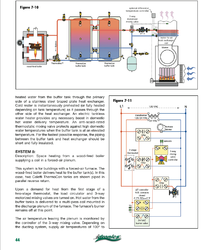I thought I was really good with figuring technical things out but I guess I just don't know enough about hydronic heating to get this straight in my mind. I was hoping someone could draw me a simple diagram to help me accomplish my goal. All the diagrams on this site have multiple zones and seem to be much more complicated than I need. I am going to order an EKO 40 and the 490 gallon preinsulated storage tank from new horizons. The EKO will be installed in a garden shed 150' f from the house. I will use thermopex(size unknown) to get the hot water into my basement where my 100,000 btu forced air furnace is located. I want to install my storage tank somewhere close to the forced air furnace. I am not bothering with domestic hot water now to keep the install as simple as possible. I will have a water to air heat exchanger in the plenum of my furnace. Since I travel some my storage may go cold more often than most peoples so the ability to heat the house before the storage reaches full temp would be nice if possible. I want to go with a pressurized system. I don't understand all the symbols yet so a key would be nice. Thanks for taking the time to help a future wood burner out.
P.S. I have about 4 cords of wood seasoning right now.
Mike
P.S. I have about 4 cords of wood seasoning right now.
Mike


